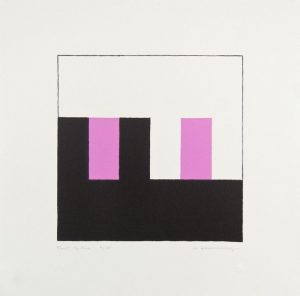During his time in New Mexico, Hammersley experimented with lithography at Tamarind and independently. His Tamarind prints reflect his interest in geometric abstraction, color, grid-based compositions, and unique titles which often inform the interactions and relationships of forms, providing the viewer with verbal insight into his non-objective compositions.
He studied at Chouinard Art Institute from 1940-42 and 1946-47 and at Jepson Art Institute from 1947-50. While serving as an Army sergeant in World War II from 1942-45 he was stationed in Paris and after he was discharged in 1945, took the opportunity to study at the École des Beaux-Arts. He also visited the studios of Picasso, Brancusi, and Cezanne. Upon his return to Southern California, he also taught at Jepson from 1948-51, at Pomona College in Claremont from 1953-62, at the Pasadena Art Museum from 1956-61, and at Chouinard from 1964-68. In 1968 he moved from Southern California to Albuquerque, NM, to teach at The University of New Mexico. In 1971 he resigned from the university to devote himself full time to making art. He remained in Albuquerque until his death.
Hammersley’s work can be found in esteemed public collections such as Achenbach Foundation for Graphic Arts, San Francisco, CA; Centre Pompidou, Paris, France; Corcoran Gallery of Art, Washington, D.C.; Getty Research Institute, Los Angeles, CA; Huntington Library, Art Collection, and Botanical Gardens, San Marino, CA; Los Angeles County Museum of Art, Los Angeles, CA; Menil Collection and Menil Drawing Institute, Houston, TX; National Gallery of Art, Washington, D.C.; Morgan Library & Museum, New York, NY; Pomona College Museum of Art, Claremont, CA; Solomon R. Guggenheim Museum, New York, NY, and many more.

